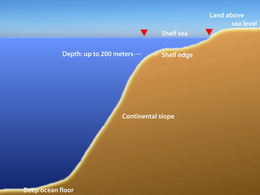Shelf Seas
| The continental shelves are shallow marine areas with a depth of up to 200 metres. Landwards, the coast forms the shelf’s border; seawards, it is bordered by the shelf edge. Here, at the so-called continental slope, the steepness of the seabed rises considerably. The seabed of the shelf areas is part of the continental landmasses. Its width varies between virtually nothing to about 1500 kilometres. |
|---|
Questions
The Questions
The research groups of the ICBM deal with a broad range of topics in the field of coastal and shelf sea research. Here, we ask questions on the key research topics. If necessary, we added explanatory notes. The questions provide an introduction into the work of the research groups. You can find more comprehensive information in the sections aimed at scientists and students as well as in the sections of each research group.
If you miss any information concerning our work, please contact us at: xxx@icbm.de.
- What happens to the mortal remains of living things? In which areas of the world do they accumulate?
- What is to be found in recent sediments and sediments from the geological past? What are the impacts on the environment?
- How can chemical substances help sessile marine organisms to prevail? Are the substances they excrete of benefit to humans?
- Which substances end up in the sea due to human actions? What happens to these substances?
- Vast amounts of tiny debris of living things are dissolved in the sea. What are the properties of these organic remains? How do they affect the marine environment? Which role do microbes play in this context?
- How do water masses move in the sea? How do marine and terrestrial sediments move?
- Debris of living things returns to the natural cycle. What are the underlying mechanisms in the sea? How do these work?
- What is modern research on species diversity?
- What is the role of single-celled microorganisms in the depths of the seabed?
- How do bacteria adapt to changing environmental conditions in the sea and elsewhere?
- Sea level rise – when, how much, and why?
- What are the modern crystal balls of marine science? Which purpose do they serve?
- How are events in the marine environment to be measured reliably and continuously – both in the short and in the long run?

![[Translate to English:]](/f/5/_processed_/3/2/csm_ICBM-Logo-transparent-_91fe1c6774.png)
